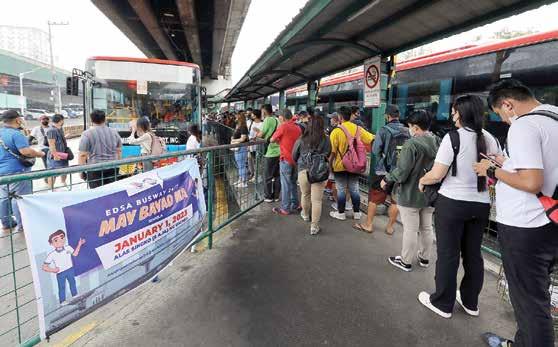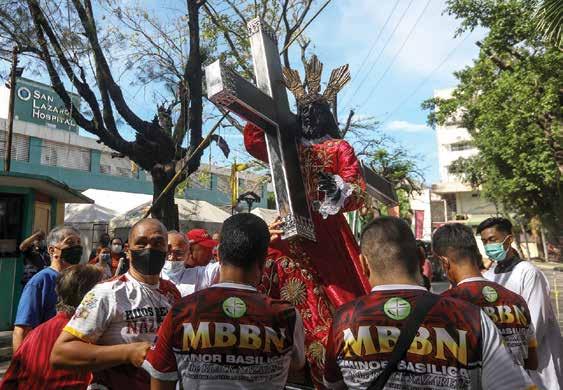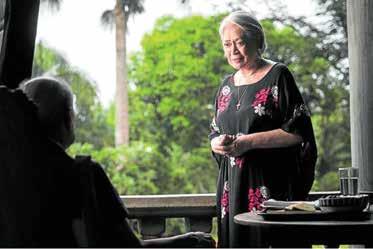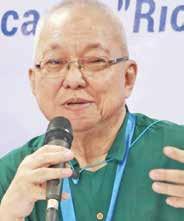Filipinos among AAPI groups a ected most by COVID in California



FILIPINOS are among the top Asian American and Pacific Islander (AAPI) groups affected by COVID-19 in California, according to data presented by the state’s Department of Public Health.
The data released during a recent webinar was to inform the public on AAPI health data disaggregation and how the information can help facilitate better outcomes and support for the community.
The Filipino community was one AAPI group seen frequently throughout data presented within the webinar.
A significant part of the meeting was the presentation of collected disaggregated data that detailed leading causes of death among AAPI groups as well as statistics regarding COVID-19. Speaker Michael C. Samuel with the CDPH Strategic Development and External Relations Fusion Center spoke first on the data related to causes of death.
Samuel showed attendees a detailed chart that compared the rate of death for various AAPI groups based on specific
Robredo heading home after US stint
FORMER Vice President Ma. Leonor “Leni” Robredo is heading home after over two months in the United States.
“Last stretch of my U.S. trip. In 2 days, I will be back home in Manila,” a post on her Facebook handle wrote on Tuesday, January 3.
In November, Robredo served as a Hauser leader at Harvard Kennedy School in Cambridge in the U.S. state of Massachusetts.
Robredo, who also serves as the chairman of Angat Buhay since stepping down as vice president last June, spoke in numerous American universities, including Princeton University, as well as at an event hosted by former U.S. president Barack Obama. Most of her talks focused on disinformation, which she had to deal with during her presidential run last year.
The former vice president’s daughters are now in different fields: Aika is presently teaching at the Ateneo de Manila University,
Marcos eyes ‘new chapter’ in relations with China
by CATHERINE S. VALENTE, KRISTINA MARALIT AND BERNADETTE TAMAYO ManilaTimes.net
DESPITE tension in the South China Sea, President Ferdinand “Bongbong” Marcos Jr. left on Tuesday, January 3 for a three-day state visit to China where he will meet with his counterpart Xi Jinping to discuss “political-security issues of a bilateral and regional nature” which the Chief Executive hopes would open a “new chapter” in relations between the two countries.
“As I leave for Beijing, I will be opening a new
chapter in our comprehensive strategic cooperation with China,” he said in his pre-departure speech at Villamor Air Base.
Marcos said he “looked forward” to his meeting with President Xi “as we work towards shifting the trajectory of our relations to a higher gear that would hopefully bring numerous prospects and abundant opportunities for the peace and development to the peoples of both our countries.”
The President also said that he would discuss “political-security issues of a bilateral and regional nature.”
“The issues between our two countries are
problems that do not belong between two friends such as [the] Philippines and China. We will seek to resolve those issues to [the] mutual benefit of our two countries,” he added.
Marcos said that he also hopes to”return home to the Philippines with a harvest of agreements and investments that will benefit our countrymen and further strengthen the foundation of our economic environment” as he is expected to sign more than 10 key bilateral agreements to add to more than 100 it already has with China.
These include cooperation in various areas
Airlines mount recovery ights
 by FRANCO JOSE C. BAROÑA AND BENJAMIN L. VERGARA ManilaTimes.net
by FRANCO JOSE C. BAROÑA AND BENJAMIN L. VERGARA ManilaTimes.net
IT will take at least three days before airlines finish the recovery flights for stranded passengers affected by the power outage that canceled flights to and from Manila on New Year’s Day, Transportation Secretary Jaime Bautista said on Monday, January 2.
Although the arrival and departure of passengers at the Ninoy Aquino International Airport (NAIA) and other airports continued on Monday, it is estimated that it will take 72 hours or 3 days before operations will normalize.
Local airlines said it will take time to fully restore their schedules as they reposition aircraft that had been held back or diverted to other airports and adjust the schedules of flights based on revised clearances in coordination with local authorities.

Bautista said that around 65,000 passengers were affected when the Air Traffic Management Center (ATMC), which serves as the facility for controlling and overseeing all inbound and outbound flights and overflights in the Philippine airspace, went down due to power outage, resulting in loss of communication, radio, radar and internet.
Airlines have been asked to operate additional flights or upgrade aircrafts in order to accommodate more passengers.
Over 2M foreign tourist arrivals in 2022 – DOT
by JOHN ERIC MENDOZA Inquirer.net
MANILA — The Philippines received and welcomed more than two million foreign tourists in 2022, the Department of Tourism said on Monday, January 2.
Data from DOT indicated that a total of 2,025,413 foreign tourists arrived in the country from February to December 2022. There is no data for January 2022 since
the country only reopened on February 10 after lifting travel restrictions due to the COVID-19 pandemic.
Most of the visitors came from the United States (505,089), South Korea (428,014) and Australia (137,974).
China ranked only tenth with only 39,627 visitors.
Meanwhile, a total of 628,445 overseas -based Filipinos also visited the country within the said period.
What we know so far about the XBB.1.5 COVID-19 subvariant
MANILA — The XBB.1.5 subvariant, a new version of the Omicron variant, is taking over the United States, raising concerns about a potential surge in COVID-19 cases.
Estimates from the U.S. Centers for Disease Control and Prevention on Friday, December 30 showed that XBB.1.5 is responsible for around 40% of the confirmed cases there, up from 20% a week ago. About 75% of cases in the Northeast— or regions spanning New Jersey through New England—are caused by the new variant.
In the Philippines, the presence of the XBB.1.5 subvariant has yet to be detected.
Here’s what we know and don’t know about the new COVID-19 subvariant. What is XBB.1.5?
XBB.1.5 is a spinoff of the Omicron XBB subvariant, which is a recombinant of the Omicron BA.2.10.1 and BA.2.75 subvariants.
The XBB subvariant drove the surges of infections in Singapore and India in October. Health authorities in the Philippines have so far detected 878 cases of the XBB subvariant.
It is unclear where XBB.1.5 came from, but it is spreading quickly.
What makes it different from XBB?
Andrew Pekosz, a virologist at Johns Hopkins University, told CNBC that XBB.1.5 is different from XBB because it has an additional mutation that makes it attach better to cells.
Are experts worried?
Some medical experts are increasingly worried about the XBB.1.5 and the XBB subvariants.
Dr. Michael Osterholm, an infectious disease expert at the University of Minnesota, told Reuters that “probably the worst variant that the world is facing right now is actually XBB.”
In a series of alarming posts on Twitter, epidemiologist Eric Feigl-Ding called the XBB.1.5 a
“super variant” and warned that it is “one of the most evasive variants against immunity.”
Yunlong Cao, a genomics researcher and assistant professor at China’s Peking University, said on Twitter last week that XBB.1.5 evades protective antibodies as effectively as the highly immune evasive XBB.1 variant and binds better to cells.
Does XBB.1.5 cause more severe illness?
Dr. Barbara Mahon, director of CDC’s Coronavirus and Other Respiratory Viruses Division, told NBC News that there is no indication that XBB.1.5 causes

Tugade on alleged fund diversion after air system tra c glitch: ‘Farthest from the truth’
 by TONETTE OREJAS Inquirer.net
by TONETTE OREJAS Inquirer.net
DATELINE USA FROM THE AJPRESS NEWS TEAM ACROSS AMERICA NORTHERN CALIFORNIA T HE F ILIPINO A MERICAN C OMMUNITY N EWSPAPER Volume 22 - No. 1 • 12 Pages JANUARY 6-12, 2023 1799 Old Bayshore Hwy, Suite 136, Burlingame, CA 94010 • Tel: (650) 689-5160 • Fax: (650) 239-9253 • www.asianjournal.com Also published in LOS ANGELES, ORANGE COUNTY/INLAND EMPIRE, SAN DIEGO, LAS VEGAS, NEW YORK/NEW JERSEY BACK TO NORMAL. Flights
PNA
PAGE 2 PAGE 4
at the Ninoy Aquino International Airport in Pasay City are back to normal on Tuesday, Jan. 3. The Civil Aviation Authority of the Philippines said operations in airports across the country are back to normal, two days after a technical issue in its Air Traffic Management Center disrupted flights on New Year’s Day.
photo by Avito Dalan
PAGE 2 PAGE 2 PAGE 2
PAGE 2
CLARK FREEPORT — Former Department of Transportation
Former Transportation Secretary Arturo Tugade Inquirer.net file photo
(DOTr) Secretary Arturo Tugade on Tuesday, Jan. 3, said he had “always instructed a backup system” to the communications,
Airlines mount recovery...
Bautista said he discussed with Manila International Airport Authority General Manager Cesar Chiong the possibility of operating the runway 24 hours until the recovery flights are over.
“We will also conduct maintenance checks of the runway on a daily basis so we can be sure that our runway is always safe,” he said.
Airlines, he added, can use the runway even at night “so their operations will also normalize.”
He said two uninterruptible power supplies (UPS) used to provide power to the air traffic management system of the Civil Aviation Authority of the Philippines (CAAP) failed, forcing CAAP to tap commercial power which caused a power surge.
“There was a problem with one UPS that was being used. When they switched to the backup UPS there was still a little problem so our technical team made a way to fix it. Unfortunately when they fixed it, the incoming power to

our equipment was 300 volts and it had an effect,” Bautista said.
He explained that the malfunction could not be avoided because the ATMC system was outdated.
At present, a back-up power supply is being used and officials have procured a replacement power supply that is expected to arrive in 30 days.
Meanwhile, the Civil Aviation Authority of the Philippines (CAAP) expressed hope that the government will release the requested P120 million budget to upgrade the system of the NAIA in Pasay City.
“As early as last year we asked for P120 million for spare parts [of the Air Traffic Management Center],” CAAP spokesman Eric Apolonio said in a radio interview over DZBB on Monday.
He said that the ATMC will be fully functional in the first quarter of 2023 if the budget is released immediately.
At least 3,000 overseas Filipino workers (OFWs) were affected
by the disruption of flights on January 1.
Department of Migrant Workers Undersecretary Hans Leo Cacdac said on Monday that all of the affected OFWs were provided assistance for the rebooking of their flights, while some 400 needed help in hotel accommodations.

Food and transportation assistance were also given to the stranded migrant workers.
The DoTr likewise liaised with the airline partners for the provision of food, refreshments, transportation, lodging and accommodation for passengers.
Philippine Airlines on Monday said that 18 domestic and three international flights were cancelled in addition to some delays caused by some flight adjustments.
Marcos eyes ‘new chapter...
PAGE 1
such as agriculture, energy, infrastructure, science and technology, trade and investment, and people-to-people exchanges, amongst others.
“In Beijing, we will seek to harness the potentials of our vibrant trade and investment relations as we accelerate the post-pandemic growth of our economy. In these meetings, I will be joined by key private sector representatives who have been and will continue to be our partners in boosting our economy,” the President said.
The President noted that China is the Philippines’ largest trading partner, a major source of official development assistance, and before the pandemic, the secondlargest source of tourist arrivals.
Meanwhile, Cebu Pacific said it continues to review its operations while AirAsia Philippines has implemented additional flight adjustments through a recovery flight on Jan. 3, 2023. g PAGE 1 PAGE 1
China accounts for 20 percent of the Philippines’ foreign trade and is also a major source of foreign direct investment.
“In undertaking this trip, I continue that legacy of strengthening the bonds of friendship established between the Filipino and Chinese peoples, and fostering bilateral ties to a higher plane of cooperation,” Marcos also said.
“Although diplomatic relations between the Philippines and China were established only 47 years ago, our history of friendly exchanges with our northern neighbor goes back centuries. Bilateral cooperation has grown steadily. Today, our ties are deep, multi-faceted, and mutually beneficial,” he added.

“We are rising as a nation, recovering from the ravages of a global pandemic. In our unremitting fight against the onslaught of COVID-19, our cooperation with China helped strengthen trust between our two countries,” Marcos said, as he expressed “profound appreciation and gratitude” when China was “the first [country] to extend its helping hand in the form of vaccines, personal protective equipment, and technical assistance at the initial onslaught of the pandemic.”
Foreign Affairs Assistant Secretary Nathaniel Imperial said in a pre-departure briefing last week that the Philippines and China will sign an agreement to set up “direct communication”
lines on issues connected to the West Philippine Sea, a disputed area, which is part of the South China Sea.
The deal aims to avoid “miscalculation and miscommunication” over the waterway, Imperial said.
Marcos’ visit to China came more than a month after his trip to Bangkok, Thailand where he met with Xi amid renewed tensions in the disputed sea.
During their meeting, both leaders agreed that the immediate conclusion of negotiations for the final and binding Code of Conduct in the South China Sea will help address the maritime disputes among littoral states.
The Philippines scored a victory against China in the Permanent Court of Arbitration in The Hague, Netherlands in 2016.
The arbitration court declared Beijing’s claim over nearly the entire South China Sea as illegal.
China has refused to acknowledge the ruling and continues to claim nearly the entire South China Sea.
While he is away, the President designated Vice President Sara Duterte as the officer in charge.
Marcos is accompanied by first lady Marie Louise “Liza” Araneta-Marcos, former president and now Senior Deputy Speaker Gloria Macapagal Arroyo, Speaker Martin Romualdez, Foreign Secretary Enrique Manalo, Finance Secretary Benjamin Diokno, Trade Secretary Alfredo Pascual, Tourism Secretary Ma. Christina Garcia Frasco, Information and Communications Technology Secretary Ivan John Uy, and other key government officials.
Opportune time
Meanwhile, Dr. Froilan Calilung, political analyst and Local Government Development Institute director, said Marcos’ state visit to China will be an opportune time for the Philippines to forge “patterns of cooperation” with the region’s economic superpower.
Calilung made the remark during a briefing in Malacañang on Tuesday when asked about the impact of the President’s visit to China.
Calilung said that Marcos himself saw the importance of his visit to China that was why he
Robredo heading home after...
Tricia is currently in Chile with Harvard Graduate School students, while her youngest, Jillian, is now working after she graduated from New York University.
“I have worked here for the past two months [in Harvard and other speaking engagements],” Robredo wrote in Filipino. “I was also able to relax and spend time with relatives since December 16. Now that I am going home,
proceeded with his trip despite the reported high COVID-19 (coronavirus disease 2019) cases there.
He said the President “believes that this state visit is going to define whatever will be the bilateral relations that will exist between the two countries at least for the next five or six years.”
He noted that China is the second world’s largest economy. “It is actually one of the top performing countries in terms of global production, sa larangan din ng (in the field of) manufacturing, value change system and everything else.”
Calilung said that the meeting between Marcos and Xi will “actually focus more on the economic bilateral aspects.”
He also said that China remains to be one of the preferred trading partners of many members of the Association of Southeast Asian Nations (Asean), including the Philippines because they benefit a lot from its trade ventures with China.
Pressed about what the decision of the two leaders would be with regard to the territorial dispute in the WPS, he said, “I think both heads of State will try to exercise utmost diplomacy in towing the line in this very, very delicate matter. But I would like to believe the statements that were made by our President that he is willing to explore patterns of cooperation with China, probably joint cooperation sa [on] oil exploration. I think that will be good for the country.”
Calilung was hopeful, however, that the President would also be “very adamant and very decisive at the same time not to give up a part of our sovereignty, not to give it up to China, because this is something that a president being the head of State and the chief architect of foreign policy should actually maintain.”
Most recently, a Filipino military commander reported that the Chinese coast guard forcibly seized Chinese rocket debris that Filipino navy personnel had retrieved in the South China Sea last month. China denied the forcible seizure. Marcos said he would seek further clarification on his visit to Beijing. g
I am energized and excited for the work that is to come.” Robredo served as vice president from 2016 to 2022. She ran for president but lost to Ferdinand Marcos Jr. (Aric John Sy Cua/ManilaTimes.net)
What we know so far about the XBB.1.5...
more severe illness than other Omicron versions.
She added that areas with many cases of the variant have not experienced a disproportionate rise in hospitalizations.
“We’re seeing hospitalizations have been notching up overall across the country… They don’t appear to be notching up more
in the areas that have more XBB.1.5,” she said.
What should Filipinos do?
The Department of Health said the government continues to implement surveillance and monitoring activities, and is confident in detecting variants that may enter the country.
“COVID-19 variants will continue to emerge and re-
emerge,” the DOH said. “What’s important is we continue to employ our layers of protection such as sanitation, masking, distancing, vaccination and boosters, as well as good ventilation to keep cases manageable and prevent virus transmission,” it added. (Gaea Katreena Cabico/Philstar.com)
Tugade on alleged fund diversion after air...
navigation, surveillance/air traffic management (CNS/ATM) systems of the Civil Aviation Authority of the Philippines (CAAP).
The air traffic management system encountered problems on Jan. 1, which delayed or canceled more than 300 flights and affected more than 55,000 passengers.
“CAAP officials who were there during our time are still

there: [Manuel Antonio] Tamayo [former DOTr undersecretary for aviation and airports], Danjun Lucas [now acting deputy director general for administration], Jim Sydiongco [former CAAP director general] and [Ricardo] Banayat [CAAP deputy director general], etc. They recommended/monitored, and implemented. Ask them,” Tugade told the Inquirer via Viber messages.
“I have always instructed
a redundancy plan,” he said, adding that Tamayo, Lucas, and Sydiongco “cannot deny this!”
“Farthest from the truth,” he added, referring to allegations he did not spend or diverted P13 billion in funds away from modernizing the CNS/ATM or putting in place the backup system.
The online news portal bilyonaro.com carried a story on that allegation. g
JANUARY 6-12, 2023 • NORCAL ASIAN JOURNAL http://www.asianjournal.com • (650) 689-5160 2 From the Front Page
PAGE 1
PAGE 1
BEACH. People from all walks of life visit the Manila Baywalk Dolomite Beach to relax and inhale fresh air during the New Year’s Day celebration on Sunday, Jan. 1. Dolomite Beach is one of the latest attractions in Manila. PNA photo by Avito Dalan
DOLOMITE
Financial Resolutions:
4 Tips And Tools To Improve Your Family’s Money Skills In 2023
T o help start the new year off strong, have open and honest conversations as a family about finances. The beginning of the year is a great opportunity to review your family’s expenses. Use this moment to review spending and savings habits, and discuss how to improve them this year. By having these open conversations with your kids, you can help them better understand the basics of money and lay a strong foundation for financial independence.
Not sure where to start? Check out these four tips that can help your family talk about your finances and build better money habits together.
1. Saving made easy for 2023 Managing your money can be overwhelming, but it doesn’t need to be. The end of the year can be especially hectic with additional expenses like holiday shopping and travel costs. To make things easier in 2023, automate your savings to help reach your financial goals faster.
With tools like Chase Autosave, customers can set up repeating, automatic transfers from their Chase checking into their Chase savings account. This presents a great learning opportunity for families to discuss the importance of savings, working towards a goal and building healthy habits.
Parents, you can show your children how you determine your savings goals and then help them set their own financial goals for the new year. Once they’ve figured out how much they want to save, help them set up a plan to get there.
2. Work together as a family to improve your finances
Working toward a common goal can make everyone feel like they have a stake in the ground. Setting financial goals together for 2023 and creating a monthly budget will help organize finances throughout the year.
As a Chase checking customer, you can open a bank account with a debit card for kids. For kids 6-17, Chase First BankingSM comes with its own debit
card and parental control, while offering several other benefits like setting spending limits and allowing them to experience money firsthand. This opens the line of communication between parents and kids about building good money habits.

3. Build healthy financial practices
Make financial discussions a regular part of family conversations.
Whether it be what or where they’re spending, how much they’re earning or their savings goal, you’ll have plenty of opportunities to discuss good money habits with your kids. To get a clearer picture of your spending and saving habits, check out their Spending Snapshot in the Chase Mobile® app. You and your kids can also set up real-time account alerts to ensure you know exactly where and how they are spending their money.
4. Prepare students heading back to school
Now that 2022 is coming to a close, it’s time to prepare students heading back to school for their second semester. Before winter break is over, talk with your high school and college students about their finances and help them feel confident in their future by laying the groundwork for financial independence.
Accounts like Chase High School CheckingSM, for students 13-17 and coowned by the parent, and Chase College CheckingSM, available to students 17-24 with no monthly service fee for five years while in college, provide access to digital banking tools to help them stay on top of their finances throughout the semester.
Using these four tips, your family can start the new year off with optimism about the state of their finances. To learn more and continue the conversation, visit chase. com/studentbanking
Chase Mobile® app is available for select mobile devices. Message and data rates may apply.
Bank deposit accounts, such as checking and savings, are subject to approval.
Deposit products provided by JPMorgan Chase Bank, N.A. Member FDIC.
(650) 689-5160 • http://www.asianjournal.com NORCAL ASIAN JOURNAL • JANUARY 6-12, 2023 3
content from JPMorgan Chase & Co.
Sponsored
Older adults can start the year of the rabbit on a healthy note even as COVID lingers
WITH vaccines and treatments, we’ve come a long way in preventing the worst outcomes from COVID-19. But older adults remain among the most at risk. As we gather together to celebrate Lunar New Year, there are many tools that older adults — and anyone — can use to help protect against a severe COVID infection.
Here are a few ways older adults and their loved ones can begin the Year of the Rabbit in the best health possible:
Get an updated vaccine. With Lunar New Year dinners and festivals quickly approaching, having an updated vaccine is an effective way to protect yourself and your loved ones — of all ages — as the celebrations ensue.
CDC recommends people 65 and older stay current with their COVID vaccines because they are at high risk of hospitalization, illness, and death from COVID. Staying up to date means getting an updated vaccine as soon as you can. An updated COVID vaccine can restore protection that has waned over time from earlier doses. If you've recently had COVID, wait three months before getting your updated vaccine.
Lunar New Year and New Year celebrations across the country this month and next will
be offering vaccine clinics with the updated vaccine, including:
• The Japanese Cultural Center of Hawai’i will be celebrating the Year of the Rabbit at its ‘Ohana Festival with a vaccine clinic 10 a.m. – 4 p.m. on Sunday, Jan. 15, at JCCH, 2454 S. Beretania St., Honolulu, HI.
• That same weekend is the San Francisco Chinese New Year Festival & Parade’s Flower Market Fair, which is taking place on Jan. 14-15 Grant Avenue and will offer vaccines.
• The Tu-Gether Lunar New Year Festival in LA takes place with a vaccine clinic on Jan. 2122 in Monterey Park, CA.
• Later that week, Chinese New Year in the Desert will be held on Jan. 28 with a spring festival—and vaccine clinic—at Fremont East Entertainment District in downtown Las Vegas.
• Chicago celebrates with the Chinatown Lunar New Parade Jan. 29, and vaccines will be available at the event, in downtown Chicago.
• San Diego’s Chinese New Year Fair will have a vaccine clinic on-site on as it celebrates on Feb. 4-5 in downtown San Diego.
• The Manhattan Chinatown Lunar New Year Parade & Festival will offer vaccines at its event on Sunday, Feb. 12, which

starts at Mott and Canal in New York at 1 p.m. Continue practicing healthy habits. In addition to vaccines, there are plenty of things you can do to help protect yourself from a COVID infection. Wash your hands regularly with soap and water. When feeling ill, stay home and rest to take care of yourself and the people you care about. Avoid crowded spaces and spaces that are not well ventilated. If you must be in those spaces, limit your time there and consider wearing a mask.
Find ways to relieve stress. The ongoing pandemic has been stressful for many people, including older adults — and admitting that is ok! Daily routines have been upended, and many have experienced increased loneliness, stress, and anxiety. Tips for coping with stress include having an open conversation with someone you trust, taking a break from the news, unwinding with physical activities that you enjoy, eating healthy foods, and finding ways to stay connected with family, friends, and community.
Updated COVID vaccines are currently free and widely available. For more information and to find a vaccine, visit www. vaccines.gov. g
Filipinos among AAPI groups affected most...
PAGE 1
causes that were ranked for each subgroup. According to the data presented by Samuel, COVID-19 was the leading cause of death for Filipinos in 2021, followed by ischemic heart disease, Alzheimer’s, stroke, and hypertensive heart disease.
This depicts how COVID-19 truly made an impact within the Filipino community, where it affected them the most out of all other AAPI groups in California. Data presented by Charsey Porse, who is with CDPH’s Center of Infectious Disease, detailed COVID’s impact even more.
According to the data that was provided, Filipinos have specifically shown a significant impact from COVID-19 based on the cases that had detailed information on race and ethnicity available.

“Among Asian patients (with known detailed race), the largest number of cases occurred within the Filipino, Indian, Chinese, and Vietnamese groups,” Charsey Porse, an epidemiologist with the CDPH, detailed.
Similar to the data provided by Samuel, Porse also revealed which groups had the highest death rates due to COVID. Once again, Filipinos were in the top of the list, alongside the Cambodian and Japanese communities. There was no data explaining why this was the case, however future data collected could lead to eventual conclusions and answers.
not only of the data but how it is used.
Rohan Radhakrishna, deputy director and chief equity officer with the CDPH’s Office of Health Equity, detailed how race and ethnicity data were collected, analyzed, and reported in five broad categories that were defined by the Federal Office of Management and Budgets since 1997, where AB 1726 is a step towards breaking down those categories for AAPI communities.
“Data disaggregation refers to the breaking down of collected data into smaller definable units to better illuminate underlying patterns and trends,” Radhakrishna noted. He went on to describe how each individual has a complex array of factors that affect their life and health.
Radhakrishna listed the following factors as immigration, socioeconomic status, nativity, language, and an individual’s experience as a minority with structural and intrapersonal racism. “These complexities are obscured when data is aggregated into broad categories,” he explained, adding that disaggregated data can therefore illuminate social and health disparities that were otherwise hidden by broader categories.
San Francisco awarded $33.7M grant to fund new adolescent psychiatric treatment facilities
SAN FRANCISCO – Mayor London N. Breed recently announced a $33.7 million state grant awarded to the San Francisco Department of Public Health (SFDPH) to build new inpatient and outpatient psychiatric facilities for youth at Zuckerberg San Francisco General Hospital (ZSFG), which will include a 12-bed psychiatric inpatient program and a 24slot intensive behavioral health outpatient program.
The grant awarded by the California Department of Health Care Services (DHCS) will address the urgent regional need for more inpatient and outpatient treatment options for adolescents who are uninsured or on MediCal, with capabilities to serve a minimum of 450 people in its inpatient unit and at least 900 intensive outpatient treatment clients annually.
“Our youth deserve the same access to quality care, but for too long San Francisco’s most vulnerable communities who are low-income or without healthcare coverage have been overlooked. When we invest in intervening and comprehensive services for this critical age group, we know they have a real shot at leading healthy and full lives,” said Mayor Breed. “I want to thank the State for recognizing the great need for this funding, which will help expand the City’s footprint of crisis and intensive services for our children and adolescent youth with significant mental health needs.”
“We are thankful to the state of California for recognizing the serious need for more psychiatric treatment options for children and teens with mental health challenges,” said Dr. Grant Colfax, San Francisco Director of Health. “Treating behavioral health concerns is lifesaving, and can protect youth from serious social consequences of untreated mental illness, including difficulty maintaining housing, connections to family and community, and employment, and premature death. By investing in public health care systems, the state is investing in the future of our youth and giving them the best opportunities to
grow and thrive.”
SFDPH Behavioral Health Services will use the funding to renovate, remodel and bring to code two large and currently unused spaces at ZSFG, the city’s public hospital and only Level 1 trauma center serving San Francisco and northern San Mateo County.
“This an extraordinary opportunity to grow our continuum of behavioral health services for youth in San Francisco,” said Dr. Hillary Kunins, Director of Behavioral Health Services. “This funding will give the city the space needed to deliver the highest quality care to young people with complex and pressing needs who are uninsured or enrolled in Medi-Cal.”
The 12-bed inpatient adolescent psychiatric hospital will operate on the seventh floor of ZSFG. The sixth floor will expand current outpatient services delivered by UCSF to include an intensive behavioral health outpatient and partial hospitalization program capable of treating as many as 24 young people at a time.
San Francisco has a robust network of behavioral health services to meet the needs of children, youth, and families.
Currently, SFDPH works with private hospitals across the Bay Area and northern California for the inpatient placement of youth experiencing mental health crisis. By building our own county-run unit in collaboration with UCSF at ZSFGH, the city has the ability to make placement decisions to ensure all adolescents have access to this critical service close to home and supported by their families. The expansion of current outpatient services at ZSFGH to include intensive outpatient treatment and partial hospital program, will allow San Francisco to create a crisis continuum for youth and families.
“I am grateful to the state of California for providing the funds necessary to meet this critical need to provide expanded inpatient and intensive outpatient services for young people,” said Dr. Susan Ehrlich,
ZSFG Chief Executive Officer. “I look forward to working with all of our partners to open these new facilities at Zuckerberg San Francisco General Hospital.”
“UCSF is excited to provide greater support and care to meet the behavioral health needs of adolescents,” said Dr. Lisa Fortuna, UCSF Executive Vice Chair in the Department of Psychiatry and Behavioral Sciences, and Chief of Psychiatry at ZSFG. “There is a need for expanding resources in our community for publicly insured children, including those in the foster and juvenile justice systems, and this grant will help enhance services that are critical to our community’s most vulnerable youth. We're thrilled to work with the San Francisco Department of Public Health to strengthen the continuum of care for children.”
The units will be fully funded by SFDPH and managed in collaboration with the University of California San Francisco (UCSF) Department of Psychiatry and Behavioral Services, with which ZSFG maintains a longstanding partnership. A timeline estimating when construction will begin, and when the programs will launch, will be determined in early 2023.
San Francisco was one of 54 awardees this year under the DHCS grant program to support new or expanded behavioral health facilities for youth.
(SF Mayor’s Office Release)

While this webinar addressed issues and disaggregated data for the AAPI community as a whole, its information is important to understanding how Filipinos fit within the AAPI community as well as what makes them different. The following sections detail the happenings of the webinar. The information acts as a crucial step towards transparency and understanding regarding health data within our community.
Data disaggregation
The issue of aggregated data takes a step towards being addressed through Assembly Bill No. 1726, written by Attorney General Rob Bonta when he was a member of the state Assembly.
With the passing of this bill, the CDPH became required (on or after July 2, 2022) to make available and collect demographic data that would include an expanded list of AAPI groups that were previously not included as subgroups. A full list of these groups can be found on CDPH’s website dedicated to the bill.
The type of data collected and how much progress has been made in the implementation of this bill was outlined in the webinar, which started with a welcome from Maral Farsi, deputy director of legislative and governmental affairs at CDPH. Attending and speaking were a variety of experts tasked with working together in and towards the implementation of AB 1726.
Karthick Ramakrishnan, chair of the California Commission on APIA (Asian and Pacific Islander American) Affairs introduced how there has so far been meaningful progress in implementation of the bill.
However, while there was progress, they also ran into challenges, specifically the pandemic. In light of this challenge, Ramakrishnan also made clear that the pandemic showed the “dire need” in collecting disaggregated data on AAPI communities.
“We know if we just collect data on ‘Asians’ we don’t have the kind of detailed understanding that we need to target the investments needed to make sure that our communities are being served adequately,” Ramakrishnan explained, hoping that this data will be used to aid in progress m ade for and within AAPI communities.
“Disaggregation doesn’t get at the heart of what this is about, which is data equity. Equity in the collection, analysis, and dissemination of data. But it’s also data to advance equity,” he added, noting the importance
“Asians aren’t a monolith,” Radhakrishna expressed, where he elaborated how ‘Asian’ is often used as an umbrella term, categorizing groups of people into one. This can therefore “reinforce inaccurate and harmful notions of the model minority” as well as lead to disproportionate access to opportunities and resources.
Implementation
Julie Nagasako, deputy director of CDPH’s Office of Policy and Planning, addressed key actions the CDPH has been taking to implement AB 1726.
“One of the critical steps that will improve our ability to share disaggregated data are updates to our vital records system, both for birth and death data,” Nagasako shared. She was transparent in expressing how as these implementations were made mid-year, in April and June, it would take a bit of time to have a complete year of data under the new protocols for collection detailed by AB 1726.
Nagasako emphasized that the collection and provision of this disaggregated data is not an effort made by one person let alone one department, rather a multitude of teams at CDPH are working on strengthening their coordination. They are aiming to build connections in an effort to better understand how to offer disaggregated data in a way that can help AAPI communities most.
Additionally, in order to ensure “data completeness” Nagasako expressed how the coordination extends to external partners as well. “AB 1726 has to do with how we manage and display the data that we generate,” she explained, highlighting that this data comes from a variety of sources, such as external surveys, federal data, and health systems to name a few.
Nagasako then spoke on another crucial part in the implementation process, where in order to make the disaggregated data available, it would be released bit by bit to the public. One of the resources she referenced, which was referenced by other speakers in the webinar, was the “Asian and Pacific Islander Data Disaggregation Brief.”
CDPH, according to Nagasako, will be incorporating disaggregated data wherever possible, such as an upcoming 2023 health assessment core module. She also noted how, based on feedback from the public, the CDPH’s website that houses the data brief will also include information about upcoming data releases, with links to where people can access them directly.
The data: Leading causes of death and COVID-19 As previously outlined, two
speakers, Michael C. Samuel and Charsey Porse spoke on highlights from disaggregated data that has so far been collected and made available to the public. Both speakers were transparent with attendees throughout, even providing thorough analyses of various data and charts provided as an example.
“Different systems often collect race and ethnicity data with different categories,” Samuel declared before proceeding to show examples of aggregated population data in California.
Referencing what Radhakrishna had detailed about how race and ethnicity data were collected, Samuel’s example of aggregated data only showed five broad categories, which included Asians and Pacific Islanders as separate entities.
“Looking at this disaggregated (or in detailed categories) is critical,” Samuel expressed. As a comparison, Samuel, then after, showed attendees charts of disaggregated data, which included a variety of AAPI groups. This highlighted how the aggregated data had so much missing.
The next set of data that Samuel presented was the chart comparing rates of death among AAPI groups.
“COVID-19 is the top leading cause of death based on age adjusted rates,” Samuel described, noting that while there is this common thread amongst the data for different groups, there are still a variety of differences. For example, for the Chinese/Taiwanese group, “lung cancer is the fifth leading cause of death as it is for Vietnamese, but it doesn’t appear in the top five in the rest of the groups,” he said.
“In conclusion, great progress has been made in analyzing and sharing disaggregated race and ethnicity data. There are important differences observed between disaggregated groups,” Samuel concluded in his section, pointing out that this data should hence be interpreted with caution in order to get an accurate understanding.
Continuing from what Samuel had spoken about, Porse provided ample detail about data collected regarding COVID-19. “Relative case and death rates of COVID have varied across racial and ethnic groups throughout the pandemic,” Porse started, before providing statistics that showed that when 2020 ended, “28% of COVID-19 cases were missing race and ethnicity data.”
However, this data with CDPH has since improved.
“Cumulatively now, about 19.5% of our COVID-19 cases are still missing race and ethnicity information, which spans the entire pandemic period,” Porse emphasized the difference in numbers.
There is still of course more to be done as many of the cases that do include race and ethnicity data, specifically for AAPI communities, are still “missing data in detailed race ethnicity subgroups,” Porse explained. She then provided more numbers, where in 2020, around 5% of California COVID cases were reported among Asians and around 89% of those cases were missing detailed race information.
“Due to the amount of missing data, we cannot calculate rates for race groups due to statistical unreliability,” Porse continued, detailing how around 12% of California’s COVID-19 deaths in 2020 were among Asians and that 16% of those deaths were missing detailed race information. This highlighted that while data was being collected, they were not enough to completely tell the story due to the lack of disaggregation.
However, Porse reassured attendees that while there was “under-reporting of detailed race information,” which makes it “hard to measure disparities and draw conclusions across subgroups.” The CDPH intends to continue to improve on data collection as well as making it available to the public. (Amrylois Ferido/AJPress)
JANUARY 6-12, 2023 • NORCAL ASIAN JOURNAL http://www.asianjournal.com • (650) 689-5160 4 Dateline USa
From the We Can Do this CoViD-19 PubliC eDuCation CamPaign
NO LONGER FREE. Passengers queue to get on board an EDSA Carousel bus at the Mega Q-Mart Station in Quezon City on Tuesday morning, Jan. 3. The minimum fare is PHP13 for the first five kilometers and additional PHP2.20 for every succeeding kilometer. PNA photo by Joey O. Razon
The new facilities at Zuckerberg San Francisco General Hospital will add inpatient and outpatient psychiatric services for youth
San Francisco Mayor London Breed File photo/www.sf.gov
Dateline PhiliPPines

Archdiocese of Cebu mourns death of Pope Emeritus Benedict XVI
by Dale G. Israel Inquirer.net
CEBU CITY — The Archdiocese of Cebu has joined others around the world in mourning the death of Pope Emeritus Benedict XVI.
Cebu Archbishop Jose Palma presided over a Requiem Mass for the late pontiff at the Cebu Metropolitan Cathedral on Monday afternoon, January 2.

A portrait of Pope Benedict XVI was placed in front of the altar, along with a zucchetto or skull cap worn by the former pope.
‘Invest Maharlika fund in infrastructure’
by Delon Porcalla Philstar.com
MANILA — One way for the government to prove that the proposed Maharlika Investment Fund (MIF) will directly benefit Filipinos is by venturing into the Marcos administration’s “Build Better More” infrastructure projects, a Mindanao lawmaker suggested on Tuesday, Jan. 3.
Rep. Johnny Pimentel of Surigao del Sur said putting the multibillion-peso funds to infrastructure development projects, especially now that the country is on the way to recovering from the pandemic, would create jobs for Filipinos and boost trade even more.
This is the best or ideal situation if it were up to him, rather than “merely hold passive assets such as fixed-income instruments, equities and bonds” of the sovereign wealth fund – the Philippines’ first – that the House of Representatives had approved last December.
“If we look at Indonesia, they are actually using their newly established sovereign wealth fund to attract private partners that can co-invest in developing highly productive infrastructure assets,” Pimentel said.
“New railways, toll
expressways and airports create more jobs that benefit lowincome Filipino families. They also expand the markets for small and medium-sized enterprises that comprise 99 percent of all registered businesses in the country,” he added.
Besides improving the mobility of people and goods, these projects also provide recurring revenue streams from train fares, toll levies, terminal fees as well as leasing and retail opportunities, Pimentel said.
“In fact, some of the largest Filipino private conglomerates have found it gainful to embark on tollways and rail transit systems, while others are going into aviation,” he said, referring to San Miguel Corp., Metro Pacific Investments Corp. and Aboitiz Equity Ventures Inc.
“We are confident the Senate will pass the bill after giving it a fair hearing and putting in further improvements,” Pimentel said.
President Marcos earlier certified the bill as urgent.
Under House Bill 6608, the MIF may invest in a wide range of real and financial assets to generate long-term social wealth savings and to fuel national economic development.
The MIF’s permissible investments include joint
Marcos, Duterte get high trust ratings in poll
by PIa lee-BraGo Philstar.com
MANILA — President Marcos received high trust and satisfaction ratings in the latest survey by The Issues and Advocacy Center (The CENTER) as the new administration completed its first six months in office.
The CENTER said it conducted anew its noncommissioned PULSO ng PILIPINO nationwide survey to gauge the public’s perception relative to the performance of the Marcos administra-tion and measured the trust rating and satisfaction rating of the President.
President Marcos and Vice President Sara Duterte both received a net rating of 81 percent and 82 percent, respectively, based on a gross trust rating of 87 percent for the President, and 88 percent for Duterte with both yielding to a similar, but negligible six percent of respondents who said they tend not to trust the country’s top two officials.
Seven percent of those polled said they are unsure of their perception for Marcos and six percent for Duterte.
The Pulso ng Pilipino survey also showed that Marcos was highly favored by 93 percent from the poorest “E” sector, 89
percent from the “D” group, and 84 percent from the upper to middle income households.
The Vice President was the preferred choice of those in the lower strata with 92 percent, 87 percent of the “D” class and 84 percent from the upper to middle income sector.
On their performance in office, Marcos ended the year with a 78 percent satisfaction rating with only four percent saying they are not satisfied with Marcos while 14 percent of the re-spondents were undecided.

Duterte registered the highest trust rating in Mindanao at 97 percent, 91 percent from Visayas, 81 percent in Luzon and, 84 percent in the National Capital Region (NCR).
Some 93 percent who trust Duterte were from the poorest sector, 87 percent were from the “D” class and 84 percent were from the upper to mid-income group.
The survey was conducted from Dec. 5 to 12, 2022 which covered some 1,200 respondents nationwide.

“The premise is to determine the level of trust and or distrust of the people towards the administration and, how satisfied or dissatisfied are the respondents with the performance of these top officials,” The CENTER said. g
ventures and infrastructure projects.
At least 20 percent of the net profits of the Maharlika Investment Corp. – the entity that would manage the MIF – will be remitted to the national treasury “to be earmarked for social welfare projects.”
Nearly 50 countries around the world have established sovereign wealth funds, many of which are funded by surplus government revenues or reserves. g
The cap was brought to Cebu City by Msgr. Jan Thomas Limchua, a Cebuano priest with a rank of a papal chaplain and a member of the household of Pope Francis at the Vatican.
Palma said Benedict XVI would be remembered for giving San Pedro Calungsod, the first saint from the Visayas and the second Filipino saint in 2012.
The late pope chose Cebu as the venue for the 51st International Eucharistic Congress in 2016.
It was also Benedict XVI who appointed Palma as the archbishop of Cebu.
“We always believe that he is God’s gift to the whole church and in particular to the
“He offered to us an example of humility and love for the church. Today, we feel that being a wonderful and loving shepherd, we pray that soon, the Church may find a way to raise him up in the altar of the Lord.”
(650) 689-5160 • http://www.asianjournal.com NORCAL ASIAN JOURNAL • JANUARY 6-12, 2023 5
Archdiocese of Cebu,” Palma said in an interview after the Mass.
During the Mass, Palma was accompanied by Cebu Auxiliary Bishop Ruben Labajo, Cebu Auxiliary Bishop Emeritus Antonio Ranola and some priests. After the Holy Mass, people crowded and approached the portrait and the skull cap inside a glass box to take pictures and offer prayers. g
Cebu Archbishop Jose Palma (holding a crosier or staff) and other local Church officials take a few minutes to pray in front of a portrait of Pope Emeritus Benedict XVI, who died in the Vatican on Saturday, December 31, 2022. Palma presided over a Requiem Mass for the late pontiff at the Cebu Metropolitan Cathedral on Monday afternoon, January 2. Inquirer.net photo
NEW YEAR BABY. Melanie Soriano gives birth to her first child, Nathalie, at the Dr. Jose Fabella Memorial Hospital in Sta. Cruz, Manila on Sunday, Jan. 1. Baby Nathalie was born at exactly midnight of Jan. 1. PNA photo by Joey O. Razon)
President Ferdinand Marcos Jr. and Vice President Sara Duterte both received a net rating of 81 percent and 82 percent, respectively, based on a gross trust rating of 87 percent for the President, and 88 percent for Duterte with both yielding to a similar, but negligible six percent of respondents who said they tend not to trust the country’s top two officials.
Philstar.com file photo
FEATURES OPINION
Safe religious devotion
The annual Traslacion or procession is not yet being revived, but a “Walk of Faith” will be held on Sunday, January 8 in Manila on the eve of the Feast of the Black Nazarene. Starting at the Quirino Grandstand in Rizal Park at 2 a.m., the procession is expected to last about three hours as participants make their way to Quiapo Church, home to the Black Nazarene image.
Devotees are allowed to bring Nazarene replicas, but nothing larger than two feet tall. The traditional pahalik or kissing of the original image is prohibited although devotees can touch the Nazareno. There will be midnight masses on Jan. 8 and 9, with Manila Archbishop Cardinal Jose Advincula celebrating the mass on the feast day itself.
Editorial
be highly evasive to both natural and vaccine immunity. Even if fully vaccinated and boosted people show only mild or no symptoms if infected by these new strains, they can pass on the virus to vulnerable members of their household such as the elderly and those with comorbidities, who can suffer serious illness or even succumb to COVID. The current dire COVID situation in China illustrates the threat posed by the new strains of the Omicron subvariant.
The Catholic Church and city officials led by Mayor Honey Lacuna, who is a physician, are appealing to participants to strictly observe basic COVID health safety protocols, starting with masking and hand hygiene. Physical distancing is still encouraged although this is not easy to observe in a procession.
Authorities are also appealing to devotees with symptoms of illness – those with fever, sore throat, continuous sneezing, coughs, cold and diarrhea –to skip the Nazarene activities. Viruses can spread rapidly in mass gatherings, and COVID-19 is still very much around, with highly infectious strains detected in the country.
These new coronavirus strains are proving to
The Philippines has lifted mandatory masking outdoors along with restrictions on religious gatherings. The Catholic Church itself, however, has found it prudent to cancel the traditional Traslacion for a third year in a row, to avoid creating a COVID superspreader event.
The Church has had its share of COVID deaths, with members of the clergy and supporting laity succumbing to the illness. In January last year, amid an Omicron-driven post-holiday surge in cases, Quiapo Church was closed to devotees and guarded by police on the Feast of the Black Nazarene, with masses instead live-streamed. This year the restrictions have been eased, but
2023: A year of economic opportunities for the Philippines
BABE ROMUALDEZ
THE World Health Organization is cautiously optimistic that the COVID-19 pandemic will no longer be a global health emergency by mid next year. According to WHO Director-General Tedros Adhanom Ghebreyesus, the number of weekly COVID-19 deaths has dropped to almost 90 percent since its peak at the end of January last year. Many experts also believe that COVID-19 will likely become endemic, meaning the virus would still be around but more manageable, like the cold or seasonal flu.
There is, however, great concern about the situation in China due to surging infection rates, compelling some countries to require travelers from China to present negative COVID-19 swab results. Whatever it is, we are all praying and hoping that the outbreak would be controlled to a certain extent and would not result in new mutations of the Omicron subvariants such
as BA.5, BA.2.75 and the BF.7 that has been identified as largely responsible for the spike in infections across China. The U.S. has offered assistance with their effective mRNA vaccines, but China has so far declined the offer. There are reports, however, that people from the mainland are getting Pfizer’s mRNA vaccine in Hong Kong.
Nevertheless, the lifting of worldwide restrictions is driving a lot of optimism that 2023 could be a year of recovery for most of the global economy, including the Philippines.
Finance Secretary Ben Diokno says “the worst is over and the best is yet to come” for the Philippines. And despite projections of a global recession this 2023, the Development Budget Coordination Committee predicts that the Philippine economy will grow by 6 to 7 percent in 2023 in the face of external headwinds.
“…an average GDP growth of 6.5 percent is nothing to be sneezed at: it is still one of the highest, if not the highest, growth rates among ASEAN+6 economies,” said Secretary Diokno, referring to the members of the Association of Southeast Asian Nations and
dialog partners Australia, China, Japan, South Korea, India and New Zealand.
Driving this optimistic economic outlook are several factors that include the early approval of the 2023 national budget; the country’s strong international credit profile that continues to be at investment grade and the stable and resilient banking system that is characterized by strong capitalization well above international norms.
He also points to the country’s adequate buffers against external headwinds, such as the hefty level of our gross international reserves of $95.1 billion as of November 2022, the low external debt to GDP ratio of 26.8 percent by the end of September 2022 and a favorable external debt profile. The Philippines also has a steady supply of foreign exchange from overseas Filipino remittances, export revenues from business process outsourcing firms, tourism receipts and inflows from foreign direct investments, Secretary Diokno disclosed.
Significantly, the policies and reforms that have removed barriers to foreign investments

to allow for more participation in Philippine industries have made the economic environment more attractive and favorable.
The “game-changing laws” such as the Public Service Act and amendments to the Retail Trade Liberalization Law are “expected to boost foreign direct investments in particular, and the economy in general,” the country’s Finance chief said. Great opportunities are certainly opening up with more countries taking interest in the Philippines as an investment destination.
No doubt all the trips of President Marcos are extremely important, leading to enhanced trade and economic partnerships worldwide.
Economic opportunities from the U.S. abound for the Philippines following the passage of the 2023 National Defense Authorization Act by the U.S. Congress, allocating a record $858 billion to the U.S. Department of Defense.
One of the significant provisions of the NDAA is outlined under Section 5949 that prohibits executive agencies from buying or obtaining any electronic parts, products or services that include “covered

semiconductor products or services” from certain Chinese companies which represent a sizeable and growing share of the chips market and a broad range of American electronic equipment such as mobile phones, networking equipment and automobile parts.
Although Section 5949 takes effect five years after the enactment of the 2023 NDAA with the Federal Acquisition Regulatory Council issuing the implementing rules and prohibitions in 2026, the Philippines can take advantage of the fallout from this legislation. Just consider, the Philippines’ semiconductor and electronics exports to the world amounted to $45.92 billion in 2021, with most of the exports going to the U.S. The Creating Helpful Incentives to Produce Semiconductors and Science Act of 2022 or CHIPS Act signed into law by President Joe Biden last August is also a positive development, according to the Semiconductor and Electronics Industries in the Philippines, as this will diversify the source of semiconductor wafers which the Philippines imports for the assembly, test and packaging
New year chaos
IRIS GONZALES
COULD the New Year chaos at the Ninoy Aquino International Airport (NAIA) be a portent of things to come for us, here in this insanely chaotic nation of 110 million? I surely hope not because this is certainly bad news for us.
Is it possible that somebody or some groups with vested interests – rumored syndicates in the airport, for instance –sabotaged aviation systems to make our airport authorities look incompetent? Wasn’t it just a few months ago that some groups desperately wanted changes in airport leadership?
Or could the rumor going around our chat groups that somebody mis-plugged an equipment which triggered the shutdown, be true? “Nasaksak sa 220 (volt) ang computer,” so goes the story in the grapevine.
There are so many conspiracy theories but what is clear is that at the end of the day, some 65,000 passengers were affected by a massive airport disruption
that happened around 9:49 a.m. of Jan. 1, the first day of 2023.
What a way to start the New Year in our land of mayhem. Just a few days ago, I wrote about the noticeably positive changes in our airport when I flew out of the country last week. I was pleasantly surprised to have enjoyed a smooth experience at NAIA. Oh how swiftly things would change.
Now, about to head back to Manila, I’m quite anxious. Would I be able to make it home or, like many other flights, would our plane be sent back in midair?
Even tycoon Manuel V. Pangilinan could not help but heave a sigh of frustration: “We’re told radar and navigation facilities at NAIA down. I was on my way home fm Tokyo – 3 hours into the flight, but had to return to Haneda. 6 hours of useless flying but inconvenience to travelers and losses to tourism and business are horrendous. Only in the PH. Sigh,” MVP tweeted on Sunday, Jan.1.
Only in the Philippines, indeed. We make positive changes once in a while, only to fall two steps backwards.
So what really happened?

Transportation Secretary Jaime Bautista, in a brief phone call, said there is absolutely no truth to the report going around that “nasaksak sa 220 (volt) ang computer.”
Sec. Jimmy was hearing a New Year’s Day mass with his wife when his phone started buzzing minutes after what turned out to be a power outage.
He immediately informed President Marcos of what happened.
Despite this – and strangely – Marcos’ social media account talked about our destiny in 2023 and nothing about how our destiny was actually unfolding with the airport mess.
What really happened was a loss of power in the Air Traffic Management Center. The exact reason for this is being investigated. The center’s uninterruptible power supply (UPS) also bogged down, crippling the country’s airspace. ATMC is the facility in charge of all inbound and outbound flights between Manila and elsewhere.
The system likewise failed to connect to the commercial power supply from Meralco.
Sec. Jimmy said the equipment was acquired in 2010 but started operations only in 2018. It also did not have a back-up system. “At around 09:49 a.m. the Air Traffic Management Center (ATMC) went down due to a power outage which resulted in loss of communication, radio, radar and internet. The primary cause identified was a problem with the power supply and the degraded uninterruptible power supply which had no link to the commercial power and had to be connected to the latter manually. The secondary problem was the power surge due to the power outage which affected the equipment,” the Transportation department said in a separate statement.
As of 5:50 p.m. on Jan. 1, operations resumed, while equipment restoration is still ongoing.
The Transportation department has instructed airline partners to provide – free of charge – food, refreshments, transportation, lodging and accommodation for all affected passengers.
The Civil Aviation Authority of the Philippines (CAAP) also advised all its airports to attend
to all stranded passengers.
These efforts are all good but at the end of the day, passengers just want to fly back home or head toward their planned destinations.
10 years behind Moving forward, Sec. Jimmy said we need to acquire an upgraded system, which would need a budget of more than P13 billion.
“With what happened today, we need to fast-track the backup system. if you compare us to Singapore, they are at least 10 years ahead of us,” he said at a press conference that day.
‘Anywhere except the Philippines’
Sadly, what happened last Sunday brought us irreversible damage and major inconvenience to tens of thousands of passengers.
I heard that in Singapore, some foreign tourists planning to head off to Boracay after landing in Manila, changed their plans and looked for other destinations instead.
Overheard from these foreigners: “Anywhere except the Philippines!”
For sure, Sec. Jimmy and his team or the Marcos
of chips. According to Mckinsey research, global demand will also continue to grow, with semiconductors poised to become a $1-trillion industry by the end of the decade.
We are catching up as a top exporter of semiconductors and electronics to the U.S., and a strong sign that the United States is looking at the Philippines as one of the alternative sources for its imports is the upcoming visit to Manila of U.S. executives from the Semiconductor Industry Association in mid-January.
As Sec. Diokno said, 2023 augurs a bright future for the Philippines – and we have the potential of being one of the leading economies in the AsiaPacific region as long as we remain focused and not “drop the ball,” with our leaders and policy makers keeping their eyes on growing our economy.
A prosperous new year to all! (Philstar.com)
* * *
The opinions, beliefs and viewpoints expressed by the author do not necessarily reflect the opinions, beliefs and viewpoints of the Asian Journal, its management, editorial board and staff.
* * * babeseyeview@gmail.com
administration for that matter only inherited this problem but it is now their duty to address it. Clearly, our aviation system –among many other systems in this country – is old and outdated. Did the previous administrations do anything to upgrade it? How about maintenance efforts?
That said, I wonder what former transportation secretary Art Tugade and the Duterte administration did to address this system. And to think secretary Tugade even wanted his son to manage our airport.
Last Sunday’s New Year chaos puts the spotlight on how we run things in this country.
As a reader pointed out, “Whatever is in place is dependent on the person in charge and not on proven procedures.”
How many more snafus can this country bear? (Philstar.com)
* * *
The opinions, beliefs and viewpoints expressed by the author do not necessarily reflect the opinions, beliefs and viewpoints of the Asian Journal, its management, editorial board and staff.

* * *
Email: eyesgonzales@gmail.com. Follow her on Twitter @eyesgonzales. Column archives at EyesWideOpen on FB.
JANUARY 6-12, 2023 • NORCAL ASIAN JOURNAL http://www.asianjournal.com • (650) 689-5160 6 ASIAN JOURNAL PUBLITIONS, INC. publishes the Los Angeles Asian Journal, published twice a week; the Orange County and Inland Empire Asian Journal, Northern lifornia Asian Journal, Las Vegas Asian Journal and the New York / New Jersey Asian Journal which are published once a week and distributed to Los Angeles, Riverside, San Bernardino, Orange Counties, Northern lifornia, Las Vegas and New York and New Jersey respectively. Articles published in this paper do not necessarily reflect the opinions of the publisher. Letters to the Editor are welcome. Letters must contain complete name and return address. The materials, however, are subject to editing and revisions. Contributions and advertising deadlines are every Mondays and Thursdays. For advertising rates and other informations, please ll the L.A. office at (213) 250-9797 or the Las Vegas Sales Office at (702) 792-6678 or send us an email at info@asianjournalinc.com Asian Journal Publications, Inc. (“AJPI”) reserves the right to refuse to publish, in its sole and absolute discretion, any advertising and advertorial material submitted for publication by client. (“Client’s Material”) Submission of an advertisement or advertorial to an AJPI sales representative does not constitute a commitment by AJPI to publish a Client’s Material. AJPI has the option to correctly classify any Client’s Material and to delete objectionable words or phrases. Client represents and warrants that a Client’s Material does not and will not contain any language or material which is libelous, slanderous or defamatory or invades any rights of privacy or publicity; does not and will not violate or infringe upon, or give rise to any adverse claim with respect to any common law or other right whatsoever (including, without limitation, any copyright, trademark, service mark or contract right) of any person or entity, or violate any other applicable law; and is not the subject of any litigation or claim that might give rise to any litigation. Publication of a Client’s Material does not constitute an agreement to continue publication. Client agrees and covenants to indemnify AJPI and its officers against any and all loss, liability, damage, expenses, cost, charges, claims, actions, causes of action, recoveries, judgments, penalties, including outside attorneys’ fees (individually and collectively “Claims”) which AJPI may suffer by reason of (1) Client’s breach of any of the representations, warranties and agreements herein or (2) any Claims by any third party relating in any way to Client’s Material. AJPI will not be liable for failure to publish any Client’s Material as requested or for more than one incorrect insertion of a Client’s Material. In the event of an error, or omission in printing or publication of a Client’s Material, AJPI shall be limited to an adjustment for the space occupied by the error, with maximum liability being cancellation of the cost of the first incorrect advertisement or republication of the correct advertisement. Under no circumstances shall Asian Publications, Inc. be liable for consequential damages of any kind. ADVERTISING AND ADVERTORIAL POLICIES The views expressed by our Op-Ed contributors are solely their own and do not necessarily reflect the predilection of the editorial board and staff of Asian Journal. Main Office: 1210 S. Brand Blvd Glendale, CA 91204 Tels: (818) 502-0651 • (213) 250-9797 Fax: (818) 502-0858 e-mail: info@asianjournalinc.com http://www.asianjournal.com ROGER LAGMAY ORIEL Publisher & Chairman of the Board
CORA MACABAGDAL-ORIEL President
MOMAR G. VISAYA Executive Editor
Vice
&
Northern
Asian Journal Northern California: 1799 Old Bayshore Hwy, Suite 136 Burlingame, CA 94010 Tel.: (650) 689-5160 • Fax: (650) 239-9253 With offices in Los Angeles, San Francisco, New York/New Jersey, Las Vegas, San Diego. Philippines
JOSEPH PERALTA
President
General Manager
California
Eyes Wide Open Babe’s Eye View
ManilaTimes.net photo
prudence is still needed in preventing Nazarenerelated activities from spreading illness and death.
Religious devotion and protecting public health need not be incompatible. (Philstar.com)
All systems go for Feast of Black Nazarene sans Traslacion
 by Franco Jose c. Baroña ManilaTimes.net
by Franco Jose c. Baroña ManilaTimes.net
IT'S all systems go for the celebration of the Feast of the Black Nazarene from Jan. 6 to 9, 2023.
BGen. Andre Dizon, Manila Police Director (MPD) director, said during the media conference at the Pope Benedict Building in Quiapo Church on Tuesday, January 3 that security measures have been put in place to ensure a peaceful and orderly celebration.
Gen. Dizon said a total of 3,000 uniformed personnel will be deployed for this religious event.
He said they will be assisted by an additional 2,000 personnel from the National Capital Region Police Office (NCRPO), police districts, and other support units and government agencies.
Dizon said the MPD will conduct a send-off ceremony
on January 5 at the Quirino Grandstand in Ermita, Manila.
He said there will also be checkpoints around the Quirino Grandstand and Quiapo areas.
Metropolitan Manila Development Authority (MMDA) General Manager Procopio Lipana, on the other hand, said they will deploy more than 700 personnel on the day of the festival, January 7.
Changes to the traditional celebration and several innovations were also introduced and announced during the media conference by Quiapo Church lay adviser Alex Irasga.
This includes the suspension of the procession of the Black Nazarene image or "Traslacion" amid the threat of COVID-19.
Irasga said a "Walk of Faith" will instead be conducted from the Quirino Grandstand to the Quiapo Church but without the image of the Black Nazarene
after the midnight Mass on January 8.
Kissing the image of the Black Nazarene, or "Pahalik", will also be prohibited.
"To avoid further contamination, we will remove the two traditions during the celebration of the feast," said Irasga.
Those planning to join the procession are encouraged to bring candles and observe health protocols such as the wearing of face masks.
Irasga said images of the Black Nazarene measuring more than two feet tall will be prohibited at the Quirino Grandstand as early as January 7.
"The celebration will be a balance of faith and obedience to the government that we will follow the minimum health protocols required," he said. "What we will spread is faith and not COVID." g
SC to decide on public interest cases this year
MANILA — After deferring ruling on cases of public interest last year, the Supreme Court (SC) is expected to decide on at least two of them this year: petitions for the postponement of the barangay and Sangguniang Kabataan Elections (BSKE), as well as on questions on the constitutionality of the nocontact apprehension policy (NCAP).
“These are some of the priority cases that we will be deciding in 2023. Hopefully, we can resolve these current pending cases that spark public interest (this) year,” Chief Justice Alexander Gesmundo said at a recent press briefing.
On Dec. 6 last year, the SC suspended the oral arguments on the case against NCAP, thereby extending the temporary restraining order (TRO) on the policy until the high court decides on the case.

Gesmundo adjourned the session with only Associate Justice Japar Dimaampao having interpellated the representatives of transport groups and asked the petitioners to file additional documents, including notices of violation.
The oral arguments will resume on Jan. 24 and will pick
up where the SC justices left off with Dimaampao interpellating Solicitor General Menardo Guevarra.
The high court deferred action on a petition by government respondents – represented by Guevarra – for the lifting of the TRO, until the oral arguments are concluded.
The NCAP is a road safety and traffic management program being implemented by the local governments of Manila, Parañaque, Quezon City, San Juan and Valenzuela, as well as along EDSA by the MMDA.
The measure has been met with widespread opposition from public utility vehicle operators and private vehicle owners due to stiff fines and the lack of stoplight countdown timers in cities.
Meanwhile, the SC is also expected to rule on election lawyer Romulo Macalintal’s petition for the Commission on Elections to resume its preparations for the BSKE as well as on a TRO on Republic Act 11935.
Signed into law by President Marcos on Oct.10, RA 11935 allows the postponement of the BSKE to October this year.
In his petition, Macalintal is
also urging the SC to order the holding of the elections at an earlier date, preferably in May.
Aside from deciding on public interest cases this year, the SC is also expected to promulgate rules governing anti-terrorism cases, as well as the writ of kalayaan, a judicial mechanism that seeks to bolster the protection of basic human rights in the country.
Gesmundo said an ad hoc committee drafting the rules on handling terrorism cases in relation to the Anti-Terrorism Act of 2020 is expected to finish its draft on or before April. This would then be submitted for consultation with the public and other legal and judicial stakeholders.
“The Court did not settle with just rendering a decision on this case. We went a step further to ensure that the implementation of the antiterrorism law is properly done when it reaches the judicial process,” the Chief Justice said.
“We want to make sure that there are specific rules governing the antiterrorism cases so that the rights of people are respected, the right of the state is also equally protected,” he added. (Philstar.com)
Marcos hopes Filipinos lives get ‘better and better’
MANILA – President Ferdinand R. Marcos Jr. expressed hope that the lives of all Filipinos would get “better and better” as the country welcomes the New Year.
In his recent vlog, Marcos was joined by Vice President and Department of Education (DepEd) Secretary Sara Duterte where the two answered a few questions from netizens.
One of the questions was: “Ano naman po ang pangarap ninyo para sa bayan ngayong 2023 (What is your dream for the country this 2023)?”
Marcos, in response, renewed his push for unity, saying it was a crucial ingredient in nationbuilding.
“Sana paganda ng paganda ang buhay ng bawat Pilipino, nagkakaisa ang Pilipinas para sa ikabubuti ng lahat. ‘Yan ang aking pangarap para sa taon na ito. Sa aking palagay, ipagpatuloy natin ang pagkakaisa natin (I hope the life of every Filipino gets better and better, the Philippines is united for the good of all. That's my dream for this year. In my opinion, let' us continue being united),” he said.
Duterte, for her part, said that she always included in her prayers for a “strong, successful, and stable Philippines.”
Marcos, who assumed office in June 2022, said he learned
something new every day because he was a bookworm.
“Araw-araw marami akong natututunan sa trabahong ito. Mabuti nalang mahilig akong magbasa. Lagi akong nag-aaral ngayon. Sa awa naman ng Diyos ay nagagamit naman natin ang ating mga natututunan para hindi mapanis ang ating pagiisip (I learn something new every day from this job. Luckily, I like to read. I always study. With God’s grace, we are able to use what we learn everyday so our mind does not get dull),” he said.
Sara said she is looking forward to completing her short course in Psychology by February.
Marcos and Duterte were also asked to predict what was in store for each other by reading each other palms.
Marcos said that he foresees Duterte being in public service for a lifetime.
“Hindi ko kailangan tignan ang palad nito… Si Inday, puso ng ina. Nakikita ko ang puso ng ina, ‘yun ang nagiging motivation niya para sa trabaho niya. Kaya sa palagay ko habangbuhay na si Inday Sara na nasa serbisyo ng publiko (I don’t need to read her palms…Inday has the heart of a mother. I can see that it will be her motivation in her work. That is why I think Sara will be in public service for life),”
he said.
Duterte actually took time to read Marcos’ palm and quipped about foreseeing that the President would soon welcome a granddaughter.
“Mayroong blessing. May apo na darating (There will be a blessing. A grandchild will arrive),” Duterte said, as a joke.
Asked to share their New Year’s Resolutions, the two had the same response: Get more sleep.
“Talagang kailangan na matuto ako na magpahinga dahil nagkakasakit na. Hindi na dapat nangyari ‘yun (We need to learn to rest because we’re getting sick. That shouldn’t happen again),” Marcos said.
He suffered from colds during his trip to Brussels, Belgium due to the cold weather there.
He said he also wanted to spend “more time with family.” Duterte said she aimed to complete eight hours of sleep rather than just five hours, which she would usually get. This was the second time that Marcos and Duterte joined each other in the former’s vlog.
Marcos said the last time they were together in a vlog was during the campaign period in April 2022.
The two ran under the UniTeam tandem -- a play on their platform of unity. (PNA)
(650) 689-5160 • http://www.asianjournal.com NORCAL ASIAN JOURNAL • JANUARY 6-12, 2023 7 Dateline PhiliPPines
BLACK NAZARENE REPLICA. Devotees hold a procession of the replica of the Black Nazarene from Quiapo Church to the vicinity of San Lazaro Hospital in Sta. Cruz, Manila on Monday, Jan. 2. To avoid crowding inside the church, the Minor Basilica of the Black Nazarene paraded the replica of the so-called miraculous image in various churches and government establishments before the feast. PNA photo by Yancy Lim
Meet the Filipina American cinematographer of ‘Black Panther: Wakanda Forever’
by KRISTOFER PURNELL Philstar.com
MARVEL'S "Black Panther: Wakanda Forever" was uplifted by its female actors; women were also pivotal for the film behind the camera, including Filipina American director of photography Autumn Durald Arkapaw.
Arkapaw grew up in the San Francisco Bay Area and graduated from the American Film Institute's (AFI) Conservatory program in 2009.
Her early film credits include shooting the films "Palo Alto," "Teen Spirit" and "The Sun Is Also A Star," as well as music videos for Janelle Monáe, HAIM, Arcade Fire and the Jonas Brothers.
Prior to the "Black Panther" sequel, Arkapaw's biggest
project was being behind the cinematography of the 2021 Marvel show "Loki," where Tom Hiddleston reprised his popular character. Autumn was nominated for an Emmy for her work on the show.
She actually replaced her friend and fellow AFI alumna, the Oscar-nominated cinematographer Rachel Morrison, on the project as Morrison had a scheduling conflict.
"When Rachel found out that she was unable to shoot, she brought my name up,” Autumn told The Hollywood Reporter. “Obviously, I was already interested. But after speaking to Ryan [Coogler] and meeting him, it just solidified that for me, because he’s a very special individual.”
In the same interview,
Arkapaw discussed the film's visual style, which explores the groundbreaking feats of the first movie and illustrates aspects of grief.
"The intention this time was to... give more scope to that world. We’re shining light more on our female protagonists … dealing with grief, rebirth,” she said.
She cited as an example the film's finale, when Letitia Wright's Shuri burns funeral clothes on the beach and mourns her brother T'Challa, played by the late Chadwick Boseman, whose soul fills both movies.
"Ryan and I wanted to [shoot] at the end of the day. That was the best light for the angle we wanted," the filmmaker recalled. "And we got a little bit lucky; there was a lot of wind
that day, and the trees were blowing. There wasn’t a ton of cloud cover. You got that nice, beautiful flare coming in the lens.”
Ricky Lee hopes more Filipinos return to cinemas and support local lms The ‘husband’ Liza Lorena will ever have
 by CHARMIE JOY PAGULONG Philstar.com
by CHARMIE JOY PAGULONG Philstar.com
NATIONAL Artist for Film and Broadcast Arts Ricky Lee wished that more Filipinos will return to the cinemas and watch local films. He also urged the government to give more assistance to the film and entertainment industry in the same way the Korean entertainment industry has received strong support from its government.
“May mga nanonood na sa atin, pero ‘pag pumasok ka sa sinehan, sometimes there are only two, three or four people inside the theaters, so nakakalungkot na isipin na ganun,” Lee said during the Pandesal Forum held recently at the Kamuning Bakery Café in Quezon City. He was conferred the Lifetime Achievement Award by the Federation of Filipino Chinese Chambers of Commerce and Industry, Inc. (FFCCCII).
“Abroad actually andami ng nanonood, andaming pumapasok. I think (streaming) will not go away because it has become a habit of the people to watch content via streaming. But I think eventually andami ng manonood sa sinehan kasi iba pa rin yung experience when you watch inside a movie house, when you look at the big screen and then you surrender yourself totally to the big screen,” he told The STAR
“When you watch a film on streaming devices, you control eh. You can edit it, you can post it… so you’re in control. The experience of watching a movie (in theaters), when you just let go, when you just lose control and let the story envelop you and bring you where it wants to go, it’s a very rare experience that you cannot experience while you are watching on streaming platforms. So, I hope that we really, really get back to watching films in movie houses,” he furthered.
Moreover, Lee shared the opinion of film industry executives that holding film festivals, such as the Metro Manila Film Festival, QCinema International Film Festival

“Yung Cinemalaya, punongpuno yung mga sinehan lalo na sa CCP (Cultural Center of the Philippines) maski na pandemic pa rin. So people are really eager to go inside the theater. Pero yung mapuno ang theater ngayon, it may take time because mahirap ang mga tao. Andaming pagkakagastusan. Ang mahalmahal ng price ng ticket. So, I suppose the government should help.”
He also stated the Philippines should learn from the Korean wave or Hallyu which includes K-pop and K-dramas. “I think there’s nothing wrong with watching foreign films, especially K-dramas where we can learn so much. But we also have to support our local content.”
“The thing with K-dramas kasi malinaw yung the Korean pride,” he observed. “’Pag nanood ka kitang-kita mo yung pride nila na Korean sila. From the food, to the music, hanggang sa damit (all the way to their fashion). The Korean pride is there. (It’s) very, very strong. I think that’s one thing that we can learn. I think we have Filipino pride pero kulang pa. I think pwede pa nating i-push yung pagiging Filipino. Because we
tend to… nakatingin tayo sa labas. Medyo na-colonized yung mind (natin).”
The renowned screenwriter likewise noted how the Korean government strongly supported its entertainment business, which he believes is what the local industry people “badly need.”
He asserted, “I think we need more support from the government and not only from the private entities. Yung Korean content, it worked, na-aappreciate siya all over the world because it comes as a wave. You have K-pop, K-drama, Korean food, Korean costume, so sabaysabay sila. It’s like a wave that’s being supported by the government. Umagos sa buong mundo ng tulong-tulong.
“Hindi sila hiwa-hiwalay which I think sa atin dapat ganun din. Tulong-tulong ang Pinoy music, Pinoy TV, Pinoy movies, Pinoy food, lahat yan supported by the government at lahat ng kailangan pa para sumuporta. We go as a wave dala-dala natin ang Pinoy pride over Filipino content.”


Meanwhile, Lee said that the FFCCCII award is “very important” to him because it “brings me back to my FilipinoChinese roots.”
Hindi na ako masyadong marunong mag-Chinese. I stopped studying Chinese when I was in Grade 5, when my father died. But I can understand a little Chinese. I just can’t speak it and I still know my Chinese name.”
The first screenplay he cowrote was Dragnet in 1973. The film starred Joseph “Erap” Ejercito Estrada as an undercover police officer, who investigates a drug syndicate.
“That was my first film and it portrayed the Chinese in a very good light. Usually ang Chinese, when they are portrayed in Philippine movies, mga chekwa, mga katatawanan stereotype. (But in Dragnet) I think that’s one of the first portrayal of Chinese that’s positive. Dun ako nagsimula,” he said of the film that gave him his
Benjamin and Chelsea now engaged
The actor made this announcement by showing himself and Robato posing in front of a neon sign bearing the words “Will you marry me?” via his Instagram page on Friday, Dec. 30. He also gave a peek at the engagement ring he had given to Robato.
“What a fairytale it is, to spend the rest of my life with you,” he said.
Fellow celebrities who sent congratulatory greetings to the couple were Solenn Heussaff, Lovi Poe and Andrea Torres. Actors Janine Gutierrez, Iza Calzado and Mark Herras said their congratulations to the pair as well.
“Congrats man! So so happy for you both!” Heussaff told Alves.
“Woot wooot! So happy for you guys!” Poe said to the couple.
“OMG (Oh my God)! Yay!” Torres gushed.
Alves and Robato celebrated their third anniversary as a couple last July. They are also business partners in their online flower shop business, House of Roses. (Inquirer.net)
 by ALLAN POLICARPIO Inquirer.net
by ALLAN POLICARPIO Inquirer.net
LIZA Lorena has been in the industry for 60 years now. And she doesn’t see herself stopping anytime soon. After all, she considers the craft of acting as her “husband.”
“I don’t see myself retiring. That will only happen if I lose my ability to memorize lines. But as long as I can do that and as long as I can walk … Well, actually, even if I do become a wheelchair user, I will still work if producers think I can still be useful,” she said at a press conference for her Metro Manila Film Festival (MMFF) entry, “Family Matters.”
“This is my life. I never got married. And so, this is my husband—my profession,” stressed Liza, who has two children: actor Tonton Gutierrez with former matinee idol Eddie Gutierrez; and Wednesday with businessman Honey Boy Palanca. Wonderful script
In “Family Matters”—directed by Nuel Naval and produced by Cineko Productions—Liza is Eleanor, a doting wife who tries her best to take care of her frail husband, Francisco (Noel Trinidad), amid growing tension among their children.
Aside from the “wonderful script,” the prospect of working with Noel for the first time made the film offer too good to pass up. “I’m a big fan of his. I have yet to work with him so thank God I got to have this opportunity in my lifetime,” she said. ‘I used to watch him on ‘Champoy’ and ‘Abangan ang Susunod na Kabanata.’”“At first, Noel was worried that I’m ‘suplada’ or ‘mataas.’ So, when we finally met, I hugged him immediately, so that he could feel comfortable with me,” she said.
Prolific show biz career Liza has had a prolific show biz
“Hopefully, in my lifetime, I get another acting award,” she said. But in an industry that puts a premium on youth, Liza observed that the roles she gets have become more limited as she grew older. But that’s OK, she said—“Lahat ay may panahon.”“I’m just thankful to God that there’s still space for us in this industry at our age, and that the industry still wants us,” she told the Inquirer. “I’m thankful to my director and all the producers who still put their trust in us.”
Aging was something Liza never really feared or felt daunted by. Growing old is a privilege denied to many, so they say. “You can never be young forever. I enjoyed every aspect of my life, from my youth to now. You can’t be young forever. You will get wrinkles and that’s part of the process. You won’t look
the same way you did, but I still feel beautiful at my age,” she said.
‘Never been happier’
Looking back at her life and career, Liza can proudly say that she has “never been happier.” “I have faced so many challenges in life, but I didn’t take them to heart. That’s all part of life,” she said. “These days, I stay with positive and happy people … I try to avoid people who make me feel unhappy or ruin my mood … people whose values don’t align with mine.”
Meanwhile, asked what advice can give young aspiring actors on how to achieve the career longevity she enjoys, Liza stressed the importance of professionalism.
“You need to learn how to apologize when you’re late. You have to be courteous to the people you work with. Greet or wish them a good morning. You have to be pleasant to everyone, especially the production staff and crew.” “If you ever find your career on a low, you will be able to come back if the industry loves you. But if you have a bad attitude, everyone will want you out,” she said.
Why Joyce enjoys marriage with Juancho
by ALEX BROSAS Inquirer.net
FOR vlogger-TV host Joyce Pring, there’s nothing more beautiful than being married to her husband Juancho Juancho Triviño who to her seems a perfect better half.


In an Instagram post on January 2, Pring articulated the reasons why she enjoyed her marriage to Triviño with whom she shared a child, Alonso Eliam. Pring is expecting another child soon.
“I think people often talk about the challenges of married life, and not enough about its beauty and blessing. I’ve experienced pretty wonderful stuff when I was single but nothing compares to this,” she said after she posted a photo of her with her husband and two photos with her son and Triviño.
She said about Triviño: “Nothing has been more beautiful or life changing than being married to someone who loves the Lord, loves me, and loves our children deeply. Someone who’s just as excited to build a life together. Someone who sticks around through
good seasons and bad seasons. Someone you can build a home with, and also call your home.”
With that, she feels that “as our family grows, our wrinkles
JANUARY 6-12, 2023 • NORCAL ASIAN JOURNAL http://www.asianjournal.com • (650) 689-5160 8
C J LIFESTYLE • CONSUMER GUIDE • COMMUNITY • MARKETPLACE INSIDE >>> Friday, January 6, 2023 FILIPINO IN NORTHERN CALIFORNIA THE ASIAN JOURNAL MAGAZINE
Arkapaw said the scene encapsulated the entire film. "It’s about family, and it’s about rebirth. It’s about trying to let go of grief, but it does stay
with you, and sometimes you have to carry it with you, and you’re reminded of it. It’s one of the most beautiful endings I think I’ve seen.”
Composite image of Autumn Durald Arkapaw and a scene from "Black Panther: Wakanda Forever" Photos from Instagram/@marvelstudios
and Cinemalaya Philippine Independent Film Festival, will also facilitate in encouraging people to return to theaters.
Benjamin Alves and Chelsea Robato Photo from Instagram/@benxalves
National Artist for Film and Broadcast Arts Ricky Lee says the Philippines should learn from the Korean wave or Hallyu, which is being strongly supported by the Korean government. Philstar.com photo
BENJAMIN Alves has revealed that he and his modelinfluencer girlfriend Chelsea Robato are now engaged, after being in a relationship for three years.
career in film and television, and has delivered memorable and award-winning performances in such movies as “Oro, Plata, Mata” (1983 FA Awards best supporting actress); “Halimaw” (1986 MMFF best actress); and “Miguelito” (1986 Gawad Urian best supporting actress).
Liza Lorena in “Family Matters”
Inquirer.net photo
deepen, and the years pass — my love for you expands and washes over me like a roaring wave. All by the grace of God that we get to experience this.”
Juancho Triviño and Joyce Pring
Photo from Instagram/@joycepring
Celebrate Lunar New Year at Graton Casino
ROHNERT PARK –
The Lucky Golden Rabbit Giveaway will be held on Friday, January 27, from 6 p.m. to 11 p.m. – $8,000 cash winner every hour, guaranteed! Plus, there will be 60 winners of $888 in free slot play. In the New Year, come and collect unexpected good fortune!

Aside from the exciting gaming, come celebrate the Year of the Rabbit at Graton with your family and friends! On Lunar New Year Day, Sunday, January 22, there will be traditional lion dance performances at 12 p.m. and 5 p.m. Also, from 1 p.m. to 6 p.m., there is God of Fortune Giveaway… join us to get your door guard! Plus, visit the rewards center starting Thursday, January 12 to get
your FREE collectible Year of the Rabbit rewards card.

There are 200 elegant comfortable rooms and luxurious suites, a glamorous lobby and luxurious spa, more than 130 table games, including Blackjack, Baccarat, Pai Gow Poker, and more at Graton. It also offers 3000 slot machines, live poker, video poker and a large function space for different music concerts and special events.
Graton Resort & Casino’s 9,000 square feet non-smoking gaming area which offers 300 slot machines and video poker is just next to the casino valet. You can enjoy gaming in a nonsmoking environment at Graton Resort & Casino!

And there are delectable restaurants and bars that offer different cuisines in the casino, such as twelve-time World Pizza Champion Chef
Tony Gemignani’s Tony’s of North Beach, Pan-Asian eatery Boathouse, a topquality steakhouse in 630 Park Steakhouse, and 500 seats at the Marketplace, which offers casual and convenient eateries for your selection. You will be surely have a happy and unforgettable experience.
Located in Sonoma County, Graton Resort & Casino has a commanding presence among the rolling hills of Northern California's wine country. Owned and operated by the Federated Indians of Graton Rancheria, Graton Resort & Casino features table games, the latest slot machines, upscale and casual dining, plus entertainment options for visitors and locals alike. For more information, please visit www.gratonresortcasino.com or call 707-588-7100.
(Advertising Supplement)
Atty. Gurfinkel answers immigration questions from Kapamilya in San Diego on part 1 of Citizen Pinoy’s ‘Your Tanong, My Sagot’

LEADING U.S. Immigration
Atty. Michael J. Gurfinkel visited San Diego, where he answered questions of Kapamilya from the “America’s Finest City” and neighboring areas. In Part 1 of “Your Tanong, My Sagot,” viewers
following
•
•
•
2023 brings new insurance protections for California consumers
SACRAMENTO — Beginning January 1, 2023, Californians will benefit from newly created consumer protections as eleven new state laws sponsored by Insurance Commissioner Ricardo Lara this past legislative session take effect. The new laws address climate change, expand health access and reproductive
care, preserve health protections, protect against fraud, and ensure public safety.
“Protecting consumers is my number one priority,” said Commissioner Lara. “Partnership with the Legislature and Governor Newsom is essential to my department’s mission of bringing fairness for all in our
oversight of the nation’s largest insurance market. I look forward to putting these eleven new laws into effect while taking further actions that benefit California consumers.”
New laws that start taking effect on January 1, 2023 include: • AB 2238, jointly authored
(650) 689-5160 • http://www.asianjournal.com NORCAL ASIAN JOURNAL • JANUARY 6-12, 2023 9 Features
YOUR TANONG, MY SAGOT IN SAN DIEGO, PART 1. Leading U.S. Immigration Atty. Michael J. Gurfinkel answers immigration questions from Kapamilya in San Diego, in Part 1 of Citizen Pinoy’s “Your Tanong, My Sagot.” Some of the questions Atty. Gurfinkel answers are – From Jefferson and Virginia: Virginia petitioned his son, Jefferson, as single but he got married. Is there a way to revive Mommy Virginia’s petition?; From Kathy of Mira Mesa: Can a person visit the U.S. as a tourist if they are under petition?; From Edith of National City: I am waiting for my green card through another daughter’s petition. My 15-year-old daughter is in the U.S. on a tourist visa extension. Is there a way my 15-year-old can stay in the U.S. with me?; The Cruz family: Grandpa Lando, Dad Allan, and grandson Chean drop by to visit Atty. Gurfinkel who worked on their case and successfully reunited the family. Watch Part 1 of “Your Tanong, My Sagot” in San Diego on an encore episode of “Citizen Pinoy” on Sunday, January (Advertising Supplement)
PAGE 10 PAGE 10
will hear answers to the
immigration concerns:
Kathy, of Mira Mesa, wants to know if a person can visit the U.S. even if they are under petition.
Raquel of San Diego is asking if she can petition her cousin in the Philippines as her caregiver.
Edith is waiting for her green card through her U.S. citizen daughter. Her other daughter who is 15 years old, is in the U.S. on a tourist visa extension. Edith wants to know how her 15-year-
Come to the all-round leisure and entertainment destination –Graton Resort & Casino – to celebrate Lunar New Year!
Fraud reports and losses: Not just a grandparent’s story
YOU might have heard that
scams mostly affect older adults, but reports to the Federal Trade Commission (FTC) tell a different story. Last year, adults under 60 — our Gen X, Millennial, and Gen Z neighbors — were more likely to report losing money to fraud than people 60 and over. And what did they report the most? Losing money to online shopping fraud, often when things pitched to them on social media never arrived.
Compared to older adults, those under 60 were more than four times as likely to report losing money on an investment scam, often a fake cryptocurrency investment opportunity, and more than five times as likely to report losing money to a job scam. Many college students reported losing money to phony job offers sent to their school email addresses. Overall, adults under 60 most often reported losing money to scams that started on social media, a website, or an app, and their median reported fraud loss
was $500.
People over 60 were less likely to report losing money to fraud, but their reported losses were higher. The median reported loss was $800 among people in their 70s and jumped to $1,500 for people over 80. Older adults were more likely to report losing money to tech support scammers — cons who urge people to pay for unneeded computer repairs — and prize, sweepstakes,
and lottery scams that demand payment but never give a prize. About one in four of the older adults’ loss reports said the scam started with a phone call.
Sharing what you know about scams helps protect people of all ages around you. Learn more at ftc.gov/PassItOn. If you see a scam, report it to the FTC at ReportFraud.ftc.gov. (Bridget Small/Consumer Education Specialist, FTC)

PhiliP
S. Chua, MD, FaCS, FPCS
Damage control
“fat hormones,” which our own endocrine glands in the body produce. There are hormones that make one eat and there are also hormones that signal the brain for the person to stop eating. These substances control hunger and satiety.
‘Hunger hormone’
The post-holiday “makeover” is just as a healthy preemptive measure, more so for those who really want to maintain their normal weight or those who have diabetes, heart disease, hypertension, hypercholesterolemia, etc.
As with anything else, damage control is best as a preventive strategy. However, special celebrations and holidays expose all of us to that great irresistible gastronomical temptation.
The hunger hormone is Ghrelin, which is secreted by our guts (stomach and intestines). When its level goes up, we feel hungry and have the urge to eat. The level of Ghrelin goes up when we get less sleep or not enough sleep. This is the reason why those who are trying to lose weight should get adequate amount (about 8 hours) of sleep.
An imbalanced meal and stress also elevate the Ghrelin level. Food deprivation obviously increases the Ghrelin level, hence it is better to keep the level of this hormone on an even keel and not fluctuate too much by eating regularly (or even more than 3 times a day) but at a controlled total calorie ceiling to maintain health and body weight.
exercises (as simple and easy as brisk walking for about 30 minutes a day), and hitting the scales daily (yes, daily) to check on any progress. This will aid you greatly in making you more religious to your overall personal health program. Drinking a lot of water (not fruit juices, and especially NOT soft drinks, which are toxic in themselves!) can help a lot.
SAN FRANCISCO – Consul General Neil Frank Ferrer met with University of San Francisco (USF) Center for Business Studies and Innovation in Asia Pacific (CBSI-AP) officers led by its Director, Dr. Xiaohua Yang, and Assistant Director, Dr. Vivian Faustino-Pulliam.
Dr. Donald Lewis, who is an adjunct professor at USF’s Department of Economics, Law
and International Business also joined the meeting.
Deputy Consul General Raquel R. Solano, Consul Vanessa Bago-Llona, Consul Rowena Pangilinan-Daquipil, and PTICSV Trade Commissioner Celynne Layug also joined the meeting to discuss possible areas of cooperation with USF’s newest full-fledged research center that focuses on business and

innovation in Asia Pacific.
USF is a Jesuit university founded in 1855, with links to Philippine-headquartered Ateneo de Manila University.
USF also has a Philippine Studies program called the Yuchengco Philippine Studies Program, which is an interdisciplinary minor specializing in the cultures and histories of the Philippine diaspora. (PCGSF Release)
For dieters, those who are watching their weight or counting calories, these occasions are tough times. Blessed are those strong-willed souls, whether or not they carry a calorie-counter on one hand and a scale on the other. These health-conscious individuals will reap their rewards in terms of stamina, energy, a stronger immune system, and even longevity, as shown by medical statistics.
Yoyo dieting is harmful
Our physiology is at the optimum when we consume just the right amount of calories to maintain our normal weight and when our glucose (blood sugar) level is on an even keel most of the time. When we over-eat and then try to starve ourselves to compensate for our indiscretion, our blood glucose spikes up and down, described as yo-yo dieting. This severe fluctuation in our blood glucose level has adverse effects on our body and on our immune system. And this poses even greater danger for persons with diabetes.
So, starving oneself is not a good way to lose weight, since this will lead to a Ghrelin “boomerang” in the latter part of the day.
‘Satiety hormone’
The opposite or counterhormone, which is called Leptin, signals the brain when to stop eating. It controls the appetite. This “satiety hormone” is produced by fat cells in the body.
When a person loses weight, the leptin level in the blood stream also goes down. As a result, there is a “rebound” weight gain. The best strategy in losing and maintaining a desired weight level is to lose in a slow and steady pace, about one to two pounds a week, and not more.
In this manner, there will still be an effective level of leptin in the body to control the urge to eat.
Appetite suppressants: Dangerous!
Excess weight that does not come down only means a greater reduction in food intake is needed. The excess weight gained over the holidays could be safely eliminated within a week. There is really no need to buy expensive prepared “diet” foods, which are nothing but high protein-low carbohydrate, calorie-portioned, meals. Rice, bread, soft drinks, and sweats are the top culprits that cause weight gain fast and increase the risk for diabetes and cardiovascular illnesses. With discipline and resolve, and daily exercise, anyone can achieve the same weight control by counting calories.
For those who are overweight to begin with, the same strategy (output of calories must exceed the intake) works like wonders. Simply put, more exercise and less food, until the scale tells you that you have achieved your dream weight (and body!) for the NEW YOU in the exciting new year.
I pray that 2023 shall be a year of new hope and that the world would be a lot wiser and smarter. Together, let us welcome and cherish each other with understanding and compassion and savor the great wonderment still ahead of us.
To all people of goodwill (and others as well) a happy new year, peace be with you, and may God bless us all around the globe.
* * *
2023 brings new insurance protections for...
by
Assemblymembers Luz Rivas, Eduardo Garcia, and former Assemblymember Cristina Garcia, directs the creation of a statewide extreme heat advance warning and ranking system based on climate and health impact information by the California Environmental Protection Agency, in coordination with the Department of Insurance and the Integrated Climate Adaption and Resiliency program in the Governor’s Office of Planning and Research. This would be the nation’s first-ever extreme heat wave ranking system when it is finalized by January 1, 2025.
• SB 852, authored by Senator Bill Dodd, authorizes the creation of Climate Resilience Districts statewide to help communities mitigate risk in advance of a disaster and promote recovery, a recommendation from the Department of Insurance’s first-ever climate insurance report that would improve access to insurance for all, so that we can better prepare ourselves from increasing climate changerelated threats. CivicWell was also a co-sponsor to this measure.
• AB 2134, jointly authored by Assemblymember Dr. Akilah Weber and former Assemblymember Cristina Garcia, establishes the “Reproductive Health Equity Program” to make available grants to providers who offer reproductive and sexual health care free of cost to patients with low incomes and those who lack health care coverage for reproductive health services, including consumers who come to California from other states that have decreased access to abortion care services. The grants afforded under AB 2134 are in addition to $40 million appropriated in the enacted 2022-23 State Budget to help cover these important health care services. Planned Parenthood Affiliates of California, NARAL Pro-Choice of California, Access Reproductive Justice, Essential Access Health, and the National Health Law Program were also co-sponsors to this measure.
• AB 1823, authored by Assemblymember Isaac Bryan, aligns the definition of student blanket policies that are purchased by colleges and universities with the federal Affordable Care Act (ACA). This alignment is necessary to ensure state regulatory oversight and that consumer protections under
• AB 2127, authored by Assemblymember Miguel Santiago, is an important followup measure to Commissioner Lara’s previously sponsored “Parent Healthcare Act” last year, that would clarify and strengthen notice requirements for Medicare-eligible older adults who are seeking to be added as dependents to their adult child’s individual health insurance policy or health care service plan contract.
• AB 2568, authored by former Assemblymember Ken Cooley, creates a “safe harbor” by stating that an individual or firm providing insurance or related services to a state legal cannabis business does not commit a crime under California law solely for providing that insurance or related service.
• SB 972, authored by Senator Lena Gonzalez, brings thousands of entrepreneurial sidewalk food vendors into a more equitable and well-regulated food economy by updating the “Safe Sidewalk Vending Act,” which Commissioner Lara authored in 2018 as a member of the California State Senate to end the criminalization of sidewalk vending. Inclusive Action for the City, Public Counsel, the Coalition for Humane Immigrant Rights, the Community Power Collective, and the Western Center on Law and Poverty –all part of the California Street Vendor Campaign – were also co-sponsors to this measure.
• SB 1040, authored by Senator Susan Rubio, authorizes the Insurance Commissioner to order restitution from persons who sell insurance without the necessary license from the Department of Insurance, including “extended vehicle warranties” sold illegally through robocalls and misappropriation of consumers’ and businesses’ premiums, among other insurance scams.
• SB 1242, authored by the Senate Committee on Insurance, bolsters anti-insurance fraud efforts essential to protecting consumers from unnecessary economic loss by further clarifying agent-broker antifraud education requirements as well as the process by which alleged fraud is reported to the Department of Insurance, in addition to other consumer protection proposals.
New laws that start taking effect in July 2023 include:
• AB 2205, authored by Assemblymember Wendy Carrillo, requires health insurers and health plans offering coverage through Covered California to report annually to the Department of Insurance and the Department of Managed Health Care the total amount of abortion funds. This new law will require transparency and disclosure from health carriers to regulators regarding the amount of separate abortion premium payments that are being collected from policyholders and distributed as claims. As we consider options available for payment of abortion services, this new law will help regulators and policymakers identify available funds to support abortion patients in California.
Planned Parenthood Affiliates of California and the National Health Law Program were also co-sponsors of this measure.
• AB 2043, authored by Assemblymember Reggie Jones-Sawyer Sr., requires all bail fugitive recovery agents, commonly known as “bounty hunters,” to be licensed by the Department of Insurance to ensure that appropriate education and training requirements are met prior to licensure and that all applicants successfully pass fingerprint-based background checks, obtain an appointment from a licensed bail agent or surety insurer, and maintain a minimum $1 million liability insurance policy so that harmed consumers have an avenue to collect damages.
In addition to these new laws, in October, Commissioner Lara enforced the nation’s first wildfire safety regulation to help drive down the cost of insurance for Californians at risk of wildfires, further protecting vulnerable consumers across the state. Commissioner Lara’s regulation is the first in the nation requiring insurance companies to provide discounts to consumers under the Safer from Wildfires framework created by the Department of Insurance in partnership with state emergency preparedness agencies. The regulation is now state law and enshrined in the California Code of Regulations. Under the new regulation, insurance companies are required to make new rate filings including wildfire safety discounts and comply with new transparency measures starting in April 2023. (CA Dep’t of Insurance Release)
Eating several times a day, even 5 or 6 times a day, NOT exceeding the total 24-hour caloric need of our body, is a healthier habit, which helps maintain our blood glucose level in a more stable, less erratic, pattern during the day. But the key is calorie-control (especially the ones from carbohydrates) combined with daily exercise.
The ‘fat hormones’
The urge to eat is controlled by hormones in our body. And these hormones fluctuate depending on how much sleep we get, what types of food we eat and how much calories we take in, and on how much physical activities we indulge in daily. Scientific researchers are focusing on specific substances they call
Most appetite control pills, juices, solutions and powders on the market are not physiological and use an unnatural way to suppress (by force) the appetite for weight control. While they are readily available and very popular, they have potential adverse side-effects on the heart, liver, kidneys and brain in the long haul. Some serious complications, and even deaths, have been reported from the use of these diet substances.
Since greater calorie intake than output is the cause of increase in body weight, the safest, most natural, strategy is to eat less and burn more calories with physical exercises, making the output of calories (energy) greater than the intake of calories (food).
The healthier “makeover” for our post-holiday misadventures includes daily gradual incremental reduction in the food we eat, daily physical
The opinions, beliefs and viewpoints expressed by the author do not necessarily reflect the opinions, beliefs and viewpoints of the Asian Journal, its management, editorial board and staff.
* * *
The main objective of this column is to educate and inspire people live a healthier lifestyle to prevent illnesses and disabilities and achieve a happier and more productive life. Any diagnosis, recommendation or treatment in our article are general medical information and not intended to be applicable or appropriate for anyone. This column is not a substitute for your physician, who knows your condition well and who is your best ally when it comes to your health.
* * * Philip S. Chua, MD, FACS, FPCS, a Cardiac Surgeon Emeritus based in Northwest Indiana and Las Vegas, Nevada, is an international medical lecturer/author, Health Advocate, newspaper columnist, and Chairman of the Filipino United Network-USA, a 501(c)3 humanitarian foundation in the United States. Websites: FUN8888.com, Today. SPSAtoday.com, and philipSchua.com; Email: scalpelpen@gmail.com.

Atty. Gurfinkel answers immigration questions...
old daughter can stay in the U.S. with her.
• Jefferson was petitioned as single by his mother, Virginia. However, he got married. Jefferson now asks if there is a way to revive his mother’s petition.
Atty. Gurfinkel also gets a surprise visit from the Cruz family. It was nearly 10 years
ago
when Atty. Gurfinkel helped the grandfather, Lando Cruz, after the U.S. Embassy in Manila denied his son Allan’s visa because of a misunderstanding. The Law Offices of Michael Gurfinkel were able to help bring Allan and his son, Chean, to the U.S. It was a memorable success story featured on Citizen Pinoy.


JANUARY 6-12, 2023 • NORCAL ASIAN JOURNAL http://www.asianjournal.com • (650) 689-5160 10 Features
Health @Heart
USF CBSI-AP officers meets with PCGSF officials PAGE 9
PAGE 9
The Cruz family is one of the success stories featured on Citizen Pinoy. (L-R) Grandson Chean, Dad Allan, and petitioner Grandpa Orlando, with leading U.S. Immigration Attorney Michael J. Gurfinkel.
(L-R) Edith, Jefferson and his mother, Virginia, and Kathy. Their questions will be answered on this episode of Citizen Pinoy.
Philippine consulate officials led by ConGen Neil Ferrer pose with USF Center for Business Studies and Innovation in Asian Pacific officers led by Director Dr. Xiaohua Yang. San Francisco PCG photo
THE holidays may be behind us but their collateral health effects, among others, will linger a while. Medically speaking, it is actually a time for “damage control” for those of us who have over-indulged during the festivities. And I plead guilty to have also succumbed to the temptation myself.
Atty. Gurfinkel answers these questions in Part 1 of
“Your Tanong, My Sagot,” with Kapamilya from San Diego and adjacent areas. Watch this encore episode of “Citizen Pinoy” on Sunday, January 8 at 6:30 PM PT (9:30 PM ET thru select Cable/ Satellite providers), right after TV Patrol Linggo. Citizen Pinoy is also available on iWantTFC.
Viewers may download the free app.
(Advertising Supplement)
the ACA are also applicable to these student health policies sold through a university or college to their enrolled students, including Dreamers and refugee students.

(650) 689-5160 • http://www.asianjournal.com NORCAL ASIAN JOURNAL • JANUARY 6-12, 2023 11

JANUARY 6-12, 2023 • NORCAL ASIAN JOURNAL http://www.asianjournal.com • (650) 689-5160 12




 by FRANCO JOSE C. BAROÑA AND BENJAMIN L. VERGARA ManilaTimes.net
by FRANCO JOSE C. BAROÑA AND BENJAMIN L. VERGARA ManilaTimes.net


 by TONETTE OREJAS Inquirer.net
by TONETTE OREJAS Inquirer.net















 by Franco Jose c. Baroña ManilaTimes.net
by Franco Jose c. Baroña ManilaTimes.net

 by CHARMIE JOY PAGULONG Philstar.com
by CHARMIE JOY PAGULONG Philstar.com



 by ALLAN POLICARPIO Inquirer.net
by ALLAN POLICARPIO Inquirer.net












